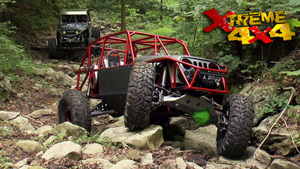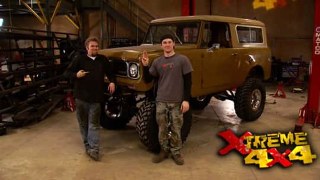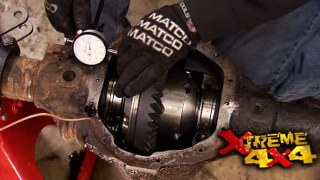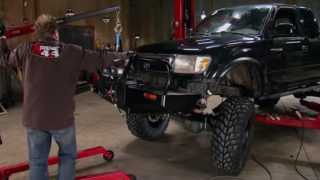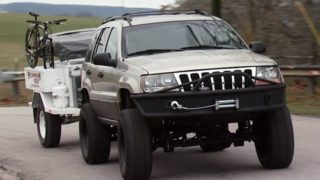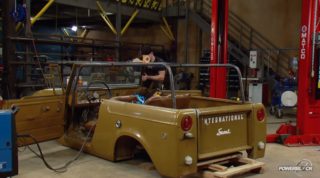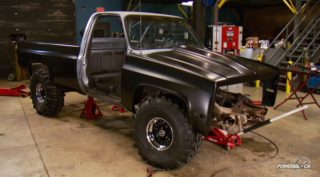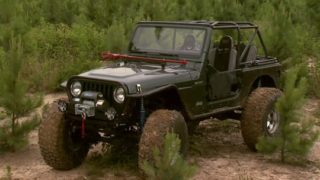More '69 International Scout 4x4 Episodes
Xtreme 4x4 Builds
Want more content like this?
Join the PowerNation Email NewsletterParts Used In This Episode
PipeMaster Tools
Pro Racer Kit:Includes: 1", 1-1/4", 1-1/2", 1-3/4" & 2" tubing tools in a foam lined plastic case.
2020 Software Solutions, Inc.
Bend-Tech PRO software.
A&A Manufacturing
Roll Cage Foot Plate.
Gen Right Off Road
Metal Tube Fenders, Aluminum Filler Panels.
MasterCraft Safety
Performance Suspension Bench Seat, Loback Rubicon seats.
MasterCraft Safety
Restraint systems in 2" and 3" versions for competitive and recreational use.
Pro-Tools
Pro Model 105 Mechanical Tube and Pipe Bender. 10 Ton Air Over Hydraulic Conversion Kit .
Tube Shark
SharkPool Combines TubeShark Bender & Notcher on Sturdy Rolling Bench.
Williams Lowbuck Tools, Inc.
LOWBUCK Tubing Bender. The Bender Frame is made of welded square tubing. You have got an 8 ton hydraulic jack to do the work for you. The Dies are made of solid cast aluminum. All of this is pre-assembled in a bender package that weighs less than 50 lbs.
Xtreme Off-Road Racing
The Xtreme Rock Racing Association, with nationwide events showcasing hard core off road vehicles racing against the clock in an awesome rock crawling/racing venue.
Episode Transcript
Today on Xtreme 4x4, we pop the top on our popular corn binder project, including detailed how to cage design that you can do yourself. Plus at only 16, this rookie rock racer has the big dogs looking over their shoulders,
no matter how many tools you've got in your shop or how much money you've got in your rig. There's one piece of equipment that if it gets damaged, your wheeling days might be done for good. That piece of equipment is you now, there is nothing worse than coming home from a day of four wheeling and find out that one of your friends got hurt or, or worse killed because of a poorly designed or non existent roll cage. And that's exactly what we're gonna do today. We're gonna take you step by step through the process of designing and building a cage. Little tips on how to do it, right, and how to make it safe and also the material you'll need to use in your project truck.
Our Scout 800 is a great project to show you guys a step by step progression of a roll cage build. It has some very common design constraints that you guys face when building cages at home like a roof and a back seat.
Here's a tip for you
don't leave your truck on the horse unattended.
Now, you don't have to pull the body off the frame to build a cage, but it does help so you can set the body on the floor and spend less time climbing in and out of the truck.
The first step to designing your roll cage is gonna be determining what type of material you wanna make it out of. Now, there's some good choices and some not so good choices. And so we'll start with a not so good choice. This is schedule 40 pipes often referred to as black iron pipe and the reason that we don't want to use, this is pipe is measured by the inside diameter and the wall thickness varies throughout the entire stick. So if you put this in your truck, you can have a weak point, you wouldn't even know it. So we're definitely not gonna be using any pipe in our project today.
Now, the first level of tubing is what's called welded seam tubing. Now, this is a piece of flat plate that's been rolled into a tube and then welded down the entire length. Now, this is an inch and a half piece and it's very economical. It only costs a dollar a foot. Now, the downfall of this is that welded seam actually creates a weak point through the entire piece, especially once it's bent. So it's not gonna be our main piece in our cage today. The next step up is do MD OM tubing starts life as welded seam tubing, they put it through a caustic wash and then they machine it with a mandrill right down the middle. So the wall thickness is ideal for the entire length of the stick and without that welded seam, there is no weak point. Now, if you're looking to build a race truck, you're gonna be looking at spending some money on some chrome Molly tubing. Now, chrome moley tubing is definitely overkill for a trail truck. It'll cost you up to $7 a foot. But if you're building a race truck, you're looking at this as an investment. Now, Dom tubing is $3 a foot and there are three popular sizes that we're gonna be looking at
inch and a half. 120 wall is great for smaller buggies, either a single seat chassis or even a Suzuki or a Toyota works great for Exo Cages. But on a larger rig, it's a little bit undersized for your full size trucks and your big buggies and three quarter 120 wall works very well. But when you're trying to fit it inside the cab, it can get a little bit tight. I like to use and five eights 120 wall dom. This used to be the industry spec for N hr A drag racing cages. The nice thing about the engine five eights is it's just a little bit smaller than inch and three quarter. It's easier to manipulate inside the truck. And especially when you're doing with a mid size truck, like our scout. Now, if you wanna save a little bit of money, here's a tip. Get Dom just enough to do all your main hoops and bents, pick up some welded seam tubing to fill in all the open spaces where you're just using straight pieces, a mix and match of dom and welded seam is perfectly acceptable and it'll save you a little bit of cash on our truck. We're gonna use all in and 58 Dom. And now that we have the material selected, we can start to design a cage
before you begin your design. It's ideal to have your seats in place. Now, we're going to be using Mastercraft low back buckets up front and a bench seat in the back. And
once we have their locations picked out, we'll take some key measurements
first, the width of the rear,
then the height from the top of the tub to the roof,
the distance from the back to the front
and from the front to the floor.
All the measurements we've just took are the outside edges of the roll cage, so it will fit inside the cab of our truck. Now, before we start to design the cage for this particular project, there's some key safety features that you need to put into any roll cage. Now, the first is gonna be what's called intersect points. Whenever you have one tube hitting a cross tube that becomes an intersect point, you need tubes on the other side to carry the load. In the advent of a rollover. If there was no tubes on the other side, the force from this tube would just cause this tube that it crosses into to bend and possibly fail. Now, the second one is triangulation. You want to have triangles in your cage. A main hoop that goes up over the driver is no good unless it's triangulated back and then through the middle, those triangles make it strong. And most importantly, you never want to have a bent tube without support in it. A perfect example is the upper cross bar you see in a lot of cages nowadays that has the bend in the middle. If you don't drop these
bars down onto the crosser, it actually is weaker. Now, before you design your cage, take a look at your vehicle, step back and actually look at the lines of your truck, don't fight them, work with them. Our scout is very square. So our cage is gonna come off with a lot of sharp square angles and that's good. That'll make it easier to design when you're working with a Jeep. You'll see guys do a lot of hoops. The reason they do that is because the jeep came from the factory with a hoop in the middle as well as the windshield has curves built into it. Our
out is perfectly square so our cage is gonna fit right in there with very minimal bends. Now, when it comes time to design your cage, it's great to get a program like Ben Tech Pro for a couple of reasons. Number one, you can design the entire cage in their assembly window, put tubes in different areas, you can render it, look at it, move it around and if there's something you don't like, you can change it, you have the entire cage built with your measurements without having to cut a single piece of tube. Changes are easy to make and you know, it's gonna fit
later on the skinny on two benders for any size wallet. But up next, Levi surely proves you don't have to be old enough for a driver's license in the XRR A extreme rock racing coming up.
Welcome back to Xtreme 4x4. Now, for the past five years, we've taken you to some pretty crazy competitions all over the country. A racing series that's been really coming on strong lately is the extreme rock racing association. Go fast driving, but with enough skill to pick your right line through the rocks. Now, today we meet a teenage rookie who's found a mentor in the legendary Shannon Campbell,
created for racers who needed to go fast on the rock
over the past five years, the XRR A has grown into the top off road series in the country. I'm hooked because I love it.
I mean, every fiber in me
waits for the next race. Mixing short course, desert racing and rock crawling. You have to be on your feet all the time. This sport was made for the racers. Big boulders jumps high horsepower,
hitting the rev limiter,
making dust, slinging rocks. It is a lot of fun.
It makes for a lot of an adrenaline rush is great. It really is. The sleepy little town of Jellicoe, Tennessee got a jolt when the XRR A US finals blasted into town
just extreme off road racing.
In the beginning.
The series attracted pro rock crawlers who wanted to jam on the skinny pedal.
I
love it. It's, it's more up my alley. I, I've always liked to go fast when we first started rock crawling. I used to drive like this.
Now a new generation is making this sport their first race of choice. You know, I'm excited about all the young kids that are stepping up and
starting to rock race.
It gives us a good feeling and one of those new kids isn't even old enough to get his driver's license being 16 and being out here. Oh, it's a thrill. I mean, because I've beaten with guys twice my age just about
Levi Shirley may be a pup, but his style is already being compared to that of off road. Great Shannon Campbell. I describe my driving style as very aggressive
and I just kind of drive my own race. Campbell has always been Levi's hero now, the legend is his racing mentor, Shannon Campbell. He's been awesome. He's to take me under his wing completely. He's just a good driver. Good kid. Got good personality.
He's one of them kids. Everybody wants. It really makes me feel good to be a part of it while borrowing Shannon's super buggy at the third event, Levi blew away the field for his first pro victory. Oh, it was awesome. I mean, I got to finally show people what I'm taking
love and a very capable rig. The wind turned heads opened eyes and breathed expectations. He's a great driver, a great person. He's actually good for our sport. Great to see people like that, continuing the sport. Exactly what we need. Humbled.
The rookie sensation knows you're only as good as your last race. There's tons of people looking at me now in the sport means I just came off a win. I have to play throughout this national championship
running 42 lap races. Only the top six would advance to the title shootout. This is the best of the best in our world in the rock race world. This is
the cream of the cross in the biggest race of its short career. Levi Shirley was just taking it in. That's awesome
on his first run. Levi made a rookie mistake
up on top of that hill. I should turn right and I went a little bit too far left. It was my mistake. My spotter the entire time was telling me go right.
I just got in the zone, you know how you get on his 2nd and 3rd runs. This Kansas native was back in the game
getting into the shootout. All came down to the fourth and final pass. I had to run under a 220 to make it in the shootout. 1st 100 yards. I got into a banner and that
cost me the entire shootout. Got a bummer heartbreaker, but I'll be out there at the first race and I'll be ready for sure. As Shannon Campbell blew away the field for the win wasn't disappointed in his protege.
He's gonna be bad. You give him a couple of years and he's gonna be running me over. I'm sure
whether you're wheeling a classic CJ, an early nineties YJ or a modern TJ when it comes to body protection. Gen right off road has you covered
with two fenders for all popular jeeps from the high and tight Boulder series to the
three and six inch flare versions for maximum tire coverage. Gen right tube fenders are made from high quality laser cut steel and 120 wall tubing for serious strengths plus three different aluminum filler panels to help dress up the looks
today on Xtreme 4x4, we're taking you guys step by step through the process of designing and building a roll cage and we're doing it inside our scout 800 A. Now, so far we've chosen our material. It's gonna be all engine 58 Dom. Plus we've come up with a good design inside our Ben Tech Pro program that we know will fit inside our cab, but more importantly, be safe. Now, obviously, the first step now is to start cutting and bending some tubing. There's lots of options here. You can spend as little as $500 on a bender like this one from William's low buck tools. It's a small bottle jack style bender and it bends on this 90 degree dye. Now, the downfall of that is it can only pull a 90 degree bend and there's no degree marking. So you can't know exactly how far you've bent that tube. So it's not ideal for serious fab work. Now, a great serious fab work bender is right here. This is a pro tools 105.
It costs just about 750 bucks and it operates in a horizontal plane. It can pull 100 and 80 degree bend, plus it has this integrated degree wheel and marker. So you'll know exactly how far you've bent the tube. Now, a lot of people will shy away from this bender because it comes as a manual style bender from the factory. But for less than $100 you can buy one of these adapter kits to adapt it to an air over hydraulic cylinder, making it a lot easier on your back.
You've seen us use the tube shark bender in the extreme shop for a few years now. And we're very happy with it. It can bend a true 180 degree bend. And because it works in this vertical axis, it tends to hold the tube very flat. When we're bending a hoop, it is a serious investment coming in at just over $2600. But that's how you have to look at it as an investment with the air over hydraulic cylinder, it can bend the tubing very quickly, most importantly, very precise. And that's what you're looking for in an investment in a tool. Now, it doesn't matter what bender you buy. Your first step is going to be to calibrate the software to your bender. The software has a simple calibration document with four easy steps. And once you have all the numbers figured out and plugged in your bend sheets will be bang on every time. Now, we've already calibrated our software for the tube shark. So this is the bender we're going to use to build our cage
with the bend sheets printed off for our cage. We can begin to cut and bend some tubing.
We'll pull the roof off the truck to make installation a little bit easier.
Then it all starts with the tubes that travel from the front to the rear
and we'll place a slug at the main hoop joint.
Bending is only part of your cage building puzzle. You're gonna need to notch a bunch of tub.
Now, you can use a plasma cutter,
a Johnny joint notch
or a stand alone notch you like on our tube shark. But either way when you're done, you're gonna want to hit it with a grinder before you tack it in place.
A couple of tools that'll make putting your cage together a lot easier would be first a ratchet strap. It can help hold these spreaders in place before you tack. Weld them in.
Go ahead and pick up one of these adjustable angle finders really helps you fine tune what angle to notch the tube in to get a nice tight fit. Now, for those complicated notches, nothing beats one of these pipe masters, you can contour it to the tube, take it off, trace it onto the tube, cut it out with the plasma
and you'll get a good fit. Pick up a bunch of angle finders, not only to check to see if your cage is level, but also to use in your bender on one of these plane clamps. This will tell you where the tube is sitting across its axis. Now, if worst case scenario and you make a mistake on a main hoop and it's too close together. One of these port packs can help spread it back into place for you to tack it in all of these tools help make building your first cage a lot easier.
So after a little bit of time with the bender and the notch or our cage is in the scout and you can see that it fits the lines of the truck very well. But more importantly, it is strong. Any load that gets picked up by this cage in a rollover will all be concentrated in this one massive joint section right here. Now, then that load will be transferred down to the frame through these two tubes here. Now, this tube
keeps the cage from rocking back and forth because it's triangulated down to the inside. Now, you're not done yet, you are not safe. If this is where you stop building your cage, you have to tie this cage into your frame. And the best way to do that is with a set of floor plates. Now, we got these from a and a manufacturing, they're less than $3 each. You want one underneath the body and then one on top, the roll cage ties
into one side and then on the other side, a piece of tubing travels down and ties it into the frame. Now, if you're driving a daily drive or something on the street every day, it's a good idea to isolate the cage with one of these little poly bushings and that'll eliminate any vibration to transfer through the cage and be picked up inside the passenger compartment. So now your cage is safe and your truck is safe, but you're not safe until we talk about your seatbelts.
Four point harnesses are a definite must for everyday wheeling. Hardcore crazy hill climbs. You wanna add the fifth point at the submarine belt to keep you planted in the seat.
Now, there are instructions that come with your belts on how to mount them. But a lot of people make a very common mistake with these upper shoulder belt mounting points. They need to be mounted one inch to four inches below your shoulder height. When you're sitting in the seat, if you mount them lower than that, like all the way down on the floor. When you roll
the truck, your spinal cord can get compressed, you'll have spinal cord damage, you want to mount them up high. So in an accident, your body continues to travel forward, not down. Now, obviously, it also goes to say that if you mount your seat belts to the cage, you also need to mount your seats there as well. And that should give you an idea, guys of what it takes to design and build your own roll cage. Don't think of it as a daunting task. Just follow the simple rules and you'll be safe when you're out wheeling.
I obviously have a little bit of work here. I get this body
back on the frame.
Show Full Transcript
no matter how many tools you've got in your shop or how much money you've got in your rig. There's one piece of equipment that if it gets damaged, your wheeling days might be done for good. That piece of equipment is you now, there is nothing worse than coming home from a day of four wheeling and find out that one of your friends got hurt or, or worse killed because of a poorly designed or non existent roll cage. And that's exactly what we're gonna do today. We're gonna take you step by step through the process of designing and building a cage. Little tips on how to do it, right, and how to make it safe and also the material you'll need to use in your project truck.
Our Scout 800 is a great project to show you guys a step by step progression of a roll cage build. It has some very common design constraints that you guys face when building cages at home like a roof and a back seat.
Here's a tip for you
don't leave your truck on the horse unattended.
Now, you don't have to pull the body off the frame to build a cage, but it does help so you can set the body on the floor and spend less time climbing in and out of the truck.
The first step to designing your roll cage is gonna be determining what type of material you wanna make it out of. Now, there's some good choices and some not so good choices. And so we'll start with a not so good choice. This is schedule 40 pipes often referred to as black iron pipe and the reason that we don't want to use, this is pipe is measured by the inside diameter and the wall thickness varies throughout the entire stick. So if you put this in your truck, you can have a weak point, you wouldn't even know it. So we're definitely not gonna be using any pipe in our project today.
Now, the first level of tubing is what's called welded seam tubing. Now, this is a piece of flat plate that's been rolled into a tube and then welded down the entire length. Now, this is an inch and a half piece and it's very economical. It only costs a dollar a foot. Now, the downfall of this is that welded seam actually creates a weak point through the entire piece, especially once it's bent. So it's not gonna be our main piece in our cage today. The next step up is do MD OM tubing starts life as welded seam tubing, they put it through a caustic wash and then they machine it with a mandrill right down the middle. So the wall thickness is ideal for the entire length of the stick and without that welded seam, there is no weak point. Now, if you're looking to build a race truck, you're gonna be looking at spending some money on some chrome Molly tubing. Now, chrome moley tubing is definitely overkill for a trail truck. It'll cost you up to $7 a foot. But if you're building a race truck, you're looking at this as an investment. Now, Dom tubing is $3 a foot and there are three popular sizes that we're gonna be looking at
inch and a half. 120 wall is great for smaller buggies, either a single seat chassis or even a Suzuki or a Toyota works great for Exo Cages. But on a larger rig, it's a little bit undersized for your full size trucks and your big buggies and three quarter 120 wall works very well. But when you're trying to fit it inside the cab, it can get a little bit tight. I like to use and five eights 120 wall dom. This used to be the industry spec for N hr A drag racing cages. The nice thing about the engine five eights is it's just a little bit smaller than inch and three quarter. It's easier to manipulate inside the truck. And especially when you're doing with a mid size truck, like our scout. Now, if you wanna save a little bit of money, here's a tip. Get Dom just enough to do all your main hoops and bents, pick up some welded seam tubing to fill in all the open spaces where you're just using straight pieces, a mix and match of dom and welded seam is perfectly acceptable and it'll save you a little bit of cash on our truck. We're gonna use all in and 58 Dom. And now that we have the material selected, we can start to design a cage
before you begin your design. It's ideal to have your seats in place. Now, we're going to be using Mastercraft low back buckets up front and a bench seat in the back. And
once we have their locations picked out, we'll take some key measurements
first, the width of the rear,
then the height from the top of the tub to the roof,
the distance from the back to the front
and from the front to the floor.
All the measurements we've just took are the outside edges of the roll cage, so it will fit inside the cab of our truck. Now, before we start to design the cage for this particular project, there's some key safety features that you need to put into any roll cage. Now, the first is gonna be what's called intersect points. Whenever you have one tube hitting a cross tube that becomes an intersect point, you need tubes on the other side to carry the load. In the advent of a rollover. If there was no tubes on the other side, the force from this tube would just cause this tube that it crosses into to bend and possibly fail. Now, the second one is triangulation. You want to have triangles in your cage. A main hoop that goes up over the driver is no good unless it's triangulated back and then through the middle, those triangles make it strong. And most importantly, you never want to have a bent tube without support in it. A perfect example is the upper cross bar you see in a lot of cages nowadays that has the bend in the middle. If you don't drop these
bars down onto the crosser, it actually is weaker. Now, before you design your cage, take a look at your vehicle, step back and actually look at the lines of your truck, don't fight them, work with them. Our scout is very square. So our cage is gonna come off with a lot of sharp square angles and that's good. That'll make it easier to design when you're working with a Jeep. You'll see guys do a lot of hoops. The reason they do that is because the jeep came from the factory with a hoop in the middle as well as the windshield has curves built into it. Our
out is perfectly square so our cage is gonna fit right in there with very minimal bends. Now, when it comes time to design your cage, it's great to get a program like Ben Tech Pro for a couple of reasons. Number one, you can design the entire cage in their assembly window, put tubes in different areas, you can render it, look at it, move it around and if there's something you don't like, you can change it, you have the entire cage built with your measurements without having to cut a single piece of tube. Changes are easy to make and you know, it's gonna fit
later on the skinny on two benders for any size wallet. But up next, Levi surely proves you don't have to be old enough for a driver's license in the XRR A extreme rock racing coming up.
Welcome back to Xtreme 4x4. Now, for the past five years, we've taken you to some pretty crazy competitions all over the country. A racing series that's been really coming on strong lately is the extreme rock racing association. Go fast driving, but with enough skill to pick your right line through the rocks. Now, today we meet a teenage rookie who's found a mentor in the legendary Shannon Campbell,
created for racers who needed to go fast on the rock
over the past five years, the XRR A has grown into the top off road series in the country. I'm hooked because I love it.
I mean, every fiber in me
waits for the next race. Mixing short course, desert racing and rock crawling. You have to be on your feet all the time. This sport was made for the racers. Big boulders jumps high horsepower,
hitting the rev limiter,
making dust, slinging rocks. It is a lot of fun.
It makes for a lot of an adrenaline rush is great. It really is. The sleepy little town of Jellicoe, Tennessee got a jolt when the XRR A US finals blasted into town
just extreme off road racing.
In the beginning.
The series attracted pro rock crawlers who wanted to jam on the skinny pedal.
I
love it. It's, it's more up my alley. I, I've always liked to go fast when we first started rock crawling. I used to drive like this.
Now a new generation is making this sport their first race of choice. You know, I'm excited about all the young kids that are stepping up and
starting to rock race.
It gives us a good feeling and one of those new kids isn't even old enough to get his driver's license being 16 and being out here. Oh, it's a thrill. I mean, because I've beaten with guys twice my age just about
Levi Shirley may be a pup, but his style is already being compared to that of off road. Great Shannon Campbell. I describe my driving style as very aggressive
and I just kind of drive my own race. Campbell has always been Levi's hero now, the legend is his racing mentor, Shannon Campbell. He's been awesome. He's to take me under his wing completely. He's just a good driver. Good kid. Got good personality.
He's one of them kids. Everybody wants. It really makes me feel good to be a part of it while borrowing Shannon's super buggy at the third event, Levi blew away the field for his first pro victory. Oh, it was awesome. I mean, I got to finally show people what I'm taking
love and a very capable rig. The wind turned heads opened eyes and breathed expectations. He's a great driver, a great person. He's actually good for our sport. Great to see people like that, continuing the sport. Exactly what we need. Humbled.
The rookie sensation knows you're only as good as your last race. There's tons of people looking at me now in the sport means I just came off a win. I have to play throughout this national championship
running 42 lap races. Only the top six would advance to the title shootout. This is the best of the best in our world in the rock race world. This is
the cream of the cross in the biggest race of its short career. Levi Shirley was just taking it in. That's awesome
on his first run. Levi made a rookie mistake
up on top of that hill. I should turn right and I went a little bit too far left. It was my mistake. My spotter the entire time was telling me go right.
I just got in the zone, you know how you get on his 2nd and 3rd runs. This Kansas native was back in the game
getting into the shootout. All came down to the fourth and final pass. I had to run under a 220 to make it in the shootout. 1st 100 yards. I got into a banner and that
cost me the entire shootout. Got a bummer heartbreaker, but I'll be out there at the first race and I'll be ready for sure. As Shannon Campbell blew away the field for the win wasn't disappointed in his protege.
He's gonna be bad. You give him a couple of years and he's gonna be running me over. I'm sure
whether you're wheeling a classic CJ, an early nineties YJ or a modern TJ when it comes to body protection. Gen right off road has you covered
with two fenders for all popular jeeps from the high and tight Boulder series to the
three and six inch flare versions for maximum tire coverage. Gen right tube fenders are made from high quality laser cut steel and 120 wall tubing for serious strengths plus three different aluminum filler panels to help dress up the looks
today on Xtreme 4x4, we're taking you guys step by step through the process of designing and building a roll cage and we're doing it inside our scout 800 A. Now, so far we've chosen our material. It's gonna be all engine 58 Dom. Plus we've come up with a good design inside our Ben Tech Pro program that we know will fit inside our cab, but more importantly, be safe. Now, obviously, the first step now is to start cutting and bending some tubing. There's lots of options here. You can spend as little as $500 on a bender like this one from William's low buck tools. It's a small bottle jack style bender and it bends on this 90 degree dye. Now, the downfall of that is it can only pull a 90 degree bend and there's no degree marking. So you can't know exactly how far you've bent that tube. So it's not ideal for serious fab work. Now, a great serious fab work bender is right here. This is a pro tools 105.
It costs just about 750 bucks and it operates in a horizontal plane. It can pull 100 and 80 degree bend, plus it has this integrated degree wheel and marker. So you'll know exactly how far you've bent the tube. Now, a lot of people will shy away from this bender because it comes as a manual style bender from the factory. But for less than $100 you can buy one of these adapter kits to adapt it to an air over hydraulic cylinder, making it a lot easier on your back.
You've seen us use the tube shark bender in the extreme shop for a few years now. And we're very happy with it. It can bend a true 180 degree bend. And because it works in this vertical axis, it tends to hold the tube very flat. When we're bending a hoop, it is a serious investment coming in at just over $2600. But that's how you have to look at it as an investment with the air over hydraulic cylinder, it can bend the tubing very quickly, most importantly, very precise. And that's what you're looking for in an investment in a tool. Now, it doesn't matter what bender you buy. Your first step is going to be to calibrate the software to your bender. The software has a simple calibration document with four easy steps. And once you have all the numbers figured out and plugged in your bend sheets will be bang on every time. Now, we've already calibrated our software for the tube shark. So this is the bender we're going to use to build our cage
with the bend sheets printed off for our cage. We can begin to cut and bend some tubing.
We'll pull the roof off the truck to make installation a little bit easier.
Then it all starts with the tubes that travel from the front to the rear
and we'll place a slug at the main hoop joint.
Bending is only part of your cage building puzzle. You're gonna need to notch a bunch of tub.
Now, you can use a plasma cutter,
a Johnny joint notch
or a stand alone notch you like on our tube shark. But either way when you're done, you're gonna want to hit it with a grinder before you tack it in place.
A couple of tools that'll make putting your cage together a lot easier would be first a ratchet strap. It can help hold these spreaders in place before you tack. Weld them in.
Go ahead and pick up one of these adjustable angle finders really helps you fine tune what angle to notch the tube in to get a nice tight fit. Now, for those complicated notches, nothing beats one of these pipe masters, you can contour it to the tube, take it off, trace it onto the tube, cut it out with the plasma
and you'll get a good fit. Pick up a bunch of angle finders, not only to check to see if your cage is level, but also to use in your bender on one of these plane clamps. This will tell you where the tube is sitting across its axis. Now, if worst case scenario and you make a mistake on a main hoop and it's too close together. One of these port packs can help spread it back into place for you to tack it in all of these tools help make building your first cage a lot easier.
So after a little bit of time with the bender and the notch or our cage is in the scout and you can see that it fits the lines of the truck very well. But more importantly, it is strong. Any load that gets picked up by this cage in a rollover will all be concentrated in this one massive joint section right here. Now, then that load will be transferred down to the frame through these two tubes here. Now, this tube
keeps the cage from rocking back and forth because it's triangulated down to the inside. Now, you're not done yet, you are not safe. If this is where you stop building your cage, you have to tie this cage into your frame. And the best way to do that is with a set of floor plates. Now, we got these from a and a manufacturing, they're less than $3 each. You want one underneath the body and then one on top, the roll cage ties
into one side and then on the other side, a piece of tubing travels down and ties it into the frame. Now, if you're driving a daily drive or something on the street every day, it's a good idea to isolate the cage with one of these little poly bushings and that'll eliminate any vibration to transfer through the cage and be picked up inside the passenger compartment. So now your cage is safe and your truck is safe, but you're not safe until we talk about your seatbelts.
Four point harnesses are a definite must for everyday wheeling. Hardcore crazy hill climbs. You wanna add the fifth point at the submarine belt to keep you planted in the seat.
Now, there are instructions that come with your belts on how to mount them. But a lot of people make a very common mistake with these upper shoulder belt mounting points. They need to be mounted one inch to four inches below your shoulder height. When you're sitting in the seat, if you mount them lower than that, like all the way down on the floor. When you roll
the truck, your spinal cord can get compressed, you'll have spinal cord damage, you want to mount them up high. So in an accident, your body continues to travel forward, not down. Now, obviously, it also goes to say that if you mount your seat belts to the cage, you also need to mount your seats there as well. And that should give you an idea, guys of what it takes to design and build your own roll cage. Don't think of it as a daunting task. Just follow the simple rules and you'll be safe when you're out wheeling.
I obviously have a little bit of work here. I get this body
back on the frame.







